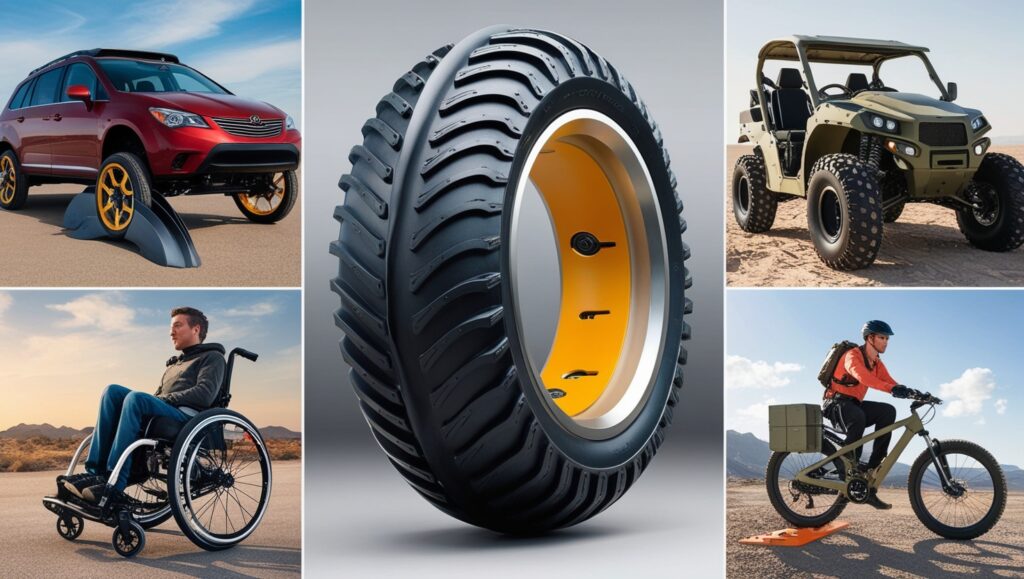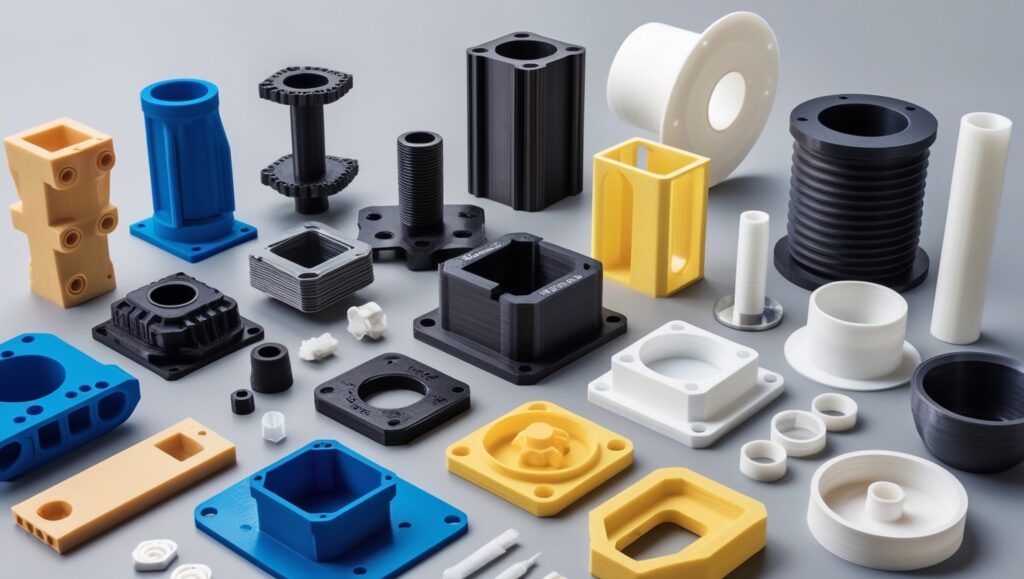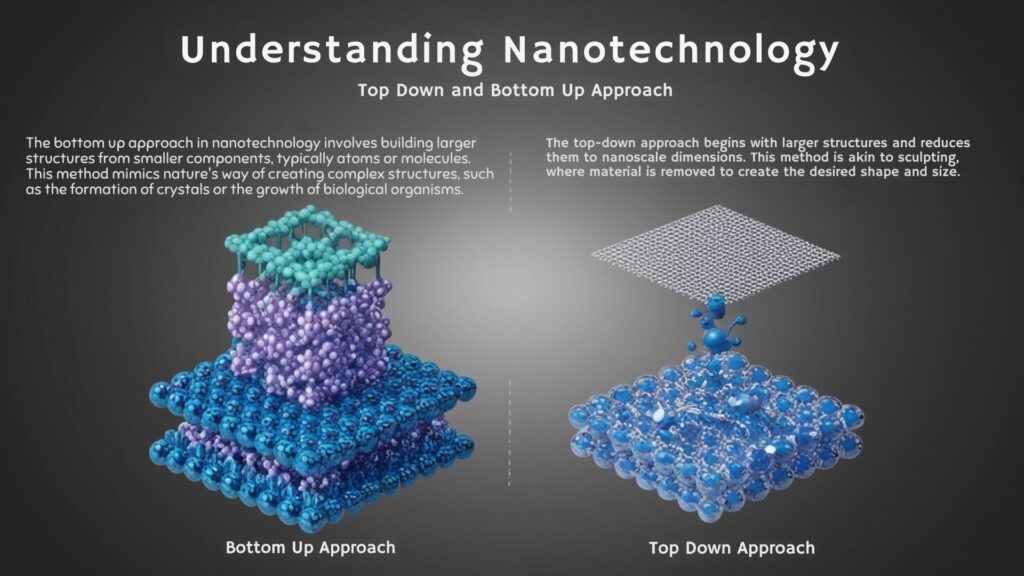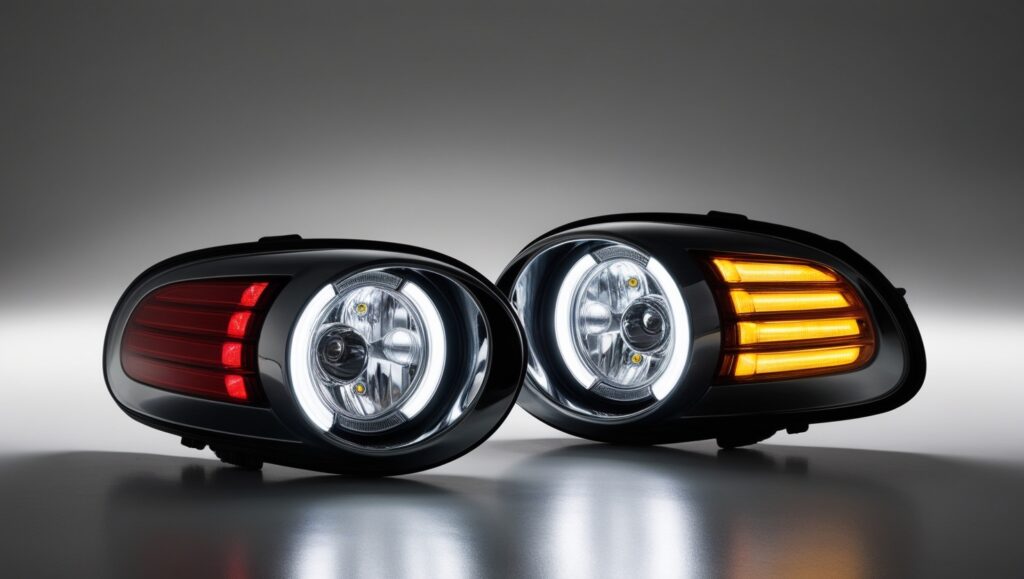
Introduction
The morphing wheel is an innovative mobility technology designed to dynamically change its shape and stiffness in response to various terrain conditions, significantly enhancing usability across diverse applications such as wheelchairs, bicycles, and military vehicles. This cutting-edge technology stems from advancements in morphing principles that can be traced back to early artistic and scientific explorations, evolving through military and aerospace innovations into the automotive industry. Its notable potential to transform transportation, improve accessibility, and adapt to challenging environments makes it a focal point of contemporary engineering research and development.
The development of morphing wheels has seen significant strides in recent years, leading to the creation of various types such as folding wheels, multi-directional wheels, and energy-harvesting wheels. Each of these designs showcases unique capabilities, including enhanced maneuverability, obstacle navigation, and energy efficiency. Noteworthy projects, such as DARPA’s Ground X-Vehicle Technologies program, highlight the application of morphing wheels in improving tactical mobility and operational effectiveness in military contexts.
Moreover, their integration into consumer products promises to redefine mobility solutions for individuals with disabilities and adventurers alike. Despite their promising advantages, morphing wheels also face challenges related to technical complexity, material limitations, manufacturing processes, and regulatory concerns. These issues can hinder widespread adoption and accessibility, particularly for smaller organizations and diverse applications outside high-performance contexts.
As ongoing research seeks to address these limitations, the future of morphing wheel technology continues to hold significant implications for enhancing safety, efficiency, and adaptability in transportation. In conclusion, morphing wheels represent a remarkable convergence of engineering, design, and practicality. Their ability to adapt in real-time to varying conditions positions them as a transformative solution in mobility technology, paving the way for future innovations in vehicles and personal mobility aids, while also inviting debates on the implications of such advancements for safety and accessibility in everyday life.
History
Early Developments in Morphing Technology
The concept of morphing technologies can be traced back to various artistic and scientific explorations, including early animations and optical devices. For example, the Fantascope, created in the 1830s, showcased morphing animations that captivated audiences by demonstrating transformation through visual arts. This laid the groundwork for later technological advancements that aimed to bring dynamic transformations into practical applications.
Military and Aerospace Innovations
During the 1960s, significant strides were made in variable-sweep aircraft technology, particularly with the General Dynamics F-111, which was designed for multiple roles and featured innovative systems such as terrain-following radar and variable-geometry wings. These technological advancements set a precedent for applying morphing principles to other fields, including the automotive industry.
Advancements in Automotive Technologies
As the automotive sector began to embrace innovation in the late 20th and early 21st centuries, concepts similar to morphing technologies started to emerge. The integration of diverse mobility solutions, autonomous driving capabilities, and connectivity signaled a shift towards vehicles that could adapt to various environments and user needs. The development of systems like the innovative wheel-track, aimed at enhancing combat vehicle maneuverability, demonstrates a move towards versatile design principles that resonate with the notion of morphing.
Current Trends and Future Prospects
Today, the automotive industry is witnessing rapid changes driven by advancements in electrification, automation, and new business models. These disruptive trends are anticipated to further propel the evolution of morphing technologies within vehicles, suggesting a future where vehicles can adapt seamlessly to their operating conditions and user demands. The ongoing exploration of such technologies promises to redefine traditional vehicle performance and consumer experiences in the years to come.
Design and Structure
Overview
The morphing wheel represents a significant advancement in mobility technology, combining innovative design principles with adaptive functionality. It is engineered to alter its shape and stiffness in response to varying terrain conditions, enhancing usability across different applications, including wheelchairs and bicycles.
Development Process
The journey from concept to the manufactured morphing wheel began with extensive play and experimentation, leading to the creation of early prototypes. These initial wheels were crafted from CNC’d aircraft-grade aluminum, allowing developers to demonstrate the advantages of foldable wheels in manual wheelchairs. The prototypes reached a critical stage known as the “looks-like, works-like” phase, where they could be tested for consumer feedback, solidifying the original idea into a tangible product.
Variable Stiffness Mechanism
Researchers in South Korea developed a unique wheel featuring variable stiffness, inspired by the surface tension of a liquid droplet. This design allows the wheel to maintain a rigid shape for stable movement on flat surfaces while enabling it to adapt its rigidity when encountering obstacles. The transition between a stiff and a deformable form occurs automatically in response to external stimuli, facilitating seamless navigation over uneven terrain.
Smart Chain Structure
The wheel’s innovative design incorporates a smart chain structure that connects to a central hub via wire spokes made from Kevlar fiber. This setup enables the adjustment of tension in the spokes to manipulate the wheel’s stiffness dynamically. The structure also employs a 3D-printed honeycomb configuration that acts as a supporting framework, allowing the wheel to remain rigid on flat ground and become softer when encountering obstacles.
Future Applications
While current developments focus on mobility aids like wheelchairs, there are potential applications in bicycle design as well. A variation of this morphing wheel could enhance folding bicycles by allowing them to feature larger wheels, thus improving their performance and usability in various environments.
Types of Morphing Wheels
Folding Wheels
Folding wheels represent a significant advancement in wheelchair design, exemplified by the Morph Wheel. This innovative wheel can transform from a standard 24-inch diameter to a compact oval shape measuring 32 by 12.5 inches, enabling easy storage in tight spaces such as airplane overhead compartments or car trunks. Made from a glass-filled nylon composite, these wheels are lightweight at just 7.5 lbs and can support a user weight of up to 265 pounds, thus enhancing mobility for wheelchair users.
Multi-Directional Wheels
Multi-directional wheels have revolutionized motion by allowing movement along multiple axes simultaneously. Unlike traditional wheels that are restricted to forward and backward motion, these wheels incorporate additional degrees of freedom, offering enhanced maneuverability and flexibility in various applications, including robotics and material handling systems. This capability is particularly beneficial in environments where precise movements are essential.
Airless Wheels
Airless wheels, a form of morphing technology, eliminate the risks associated with punctures and air pressure maintenance. These wheels are designed with advanced structures such as honeycomb patterns or materials inspired by NASA’s Mars rovers, making them a more sustainable option for various vehicles. Their reliable performance and reduced maintenance requirements enhance their appeal in both consumer and commercial markets.
Morphing Shape Wheels
These wheels can dynamically change their shape and tread pattern based on the driving conditions, offering improved off-road capabilities and performance. By utilizing advanced materials, such as shape-memory alloys, morphing shape wheels can adapt their structure—flattening for smooth roads or altering tread patterns for enhanced traction on rugged terrain. This adaptability opens new possibilities for exploration and adventure in off-road environments.
Energy-Harvesting Wheels
Energy-harvesting wheels are engineered to capture and convert kinetic energy generated during vehicle motion. This innovative design aims to supplement the power supply of electric or hybrid vehicles, enhancing their efficiency and sustainability. By harnessing energy that would otherwise be lost, these wheels represent a forward-thinking approach to eco-friendly transportation solutions. Through these various types of morphing wheels, the future of mobility continues to evolve, enhancing not only the functionality and efficiency of vehicles but also improving user experience and safety across multiple platforms.
Applications
Ground X-Vehicle Technologies
The Ground X-Vehicle Technologies (GXV-T) program, developed by DARPA, aims to enhance the mobility, survivability, and effectiveness of future combat vehicles by leveraging innovative wheel technologies. Major Amber Walker, the program manager, highlighted the program’s focus on improving tactical mobility across diverse terrains while reducing reliance on traditional armor. The GXV-T utilizes advanced wheel designs that enable vehicles to navigate complex landscapes more efficiently, thus enhancing overall operational capability without the added weight of armor.
Transformable Wheels
The design of transformable wheels has been a significant breakthrough in robotics and autonomous vehicles. These wheels can adapt to various terrains, offering improved obstacle-crossing capabilities. For instance, hybrid robots equipped with transformable wheels can traverse both smooth surfaces and rugged landscapes, enabling applications in areas like search and rescue operations, environmental monitoring, and military logistics.
Virtual Navigation Technologies
Additionally, morphing wheel technology has been integrated with advanced navigation systems such as Virtual Perspectives Augmenting Natural Experiences (V-PANE). This system employs an array of mounted LIDAR and video cameras to create real-time models of a vehicle’s surroundings, effectively simulating windows for windowless designs. Such innovations allow operators to have a comprehensive view of their environment, enhancing situational awareness and operational efficiency.
Animation and Visual Effects
Morphing technology also finds applications beyond mobility, particularly in animation and visual effects. Software developed in the 1990s popularized morphing techniques, enabling seamless transitions in animations such as the transformation of spacecraft in films like “Flight of the Navigator.” This application demonstrates the versatility of morphing technology, showcasing its potential for creative and practical uses in media and entertainment.
Future Prospects
The future of automotive mobility is increasingly shaped by emerging trends such as electrification, shared mobility, and autonomous driving, all of which significantly influence consumer behavior and market dynamics. As private car ownership declines in preference for on-demand solutions, the automotive industry is projected to expand its revenue streams by approximately 30 percent, potentially adding up to $1.5 trillion by 2030 through innovative business models and connectivity services.
Electric vehicles (EVs) are becoming mainstream, with projections indicating that they will comprise about 30 percent of new car sales globally by the end of this decade, up from just 4 percent in 2020. This surge in EV adoption is driven by favorable government policies, technological advancements, and growing consumer awareness of sustainability. Countries such as California and New York are mandating zero-emission vehicles by 2035, which could further accelerate this transition.
Additionally, advancements in autonomous driving technologies are expected to reshape transportation. Despite current challenges such as pricing and consumer acceptance, a progressive scenario anticipates that fully autonomous vehicles could represent up to 15 percent of worldwide passenger vehicle sales by 2030. As connectivity improves, vehicles are evolving into platforms that allow passengers to engage in various activities during transit, highlighting the need for cars to be adaptable and upgradable to keep pace with rapid technological advancements.
While the unit sales of vehicles may continue to grow, they are expected to do so at a more modest rate of about 2 percent annually. This is reflective of changing consumer preferences, urban planning trends that discourage private car use, and the growing prevalence of shared mobility solutions.
Advantages
Enhanced Adaptability
One of the primary advantages of morphing wheels is their ability to adapt to various terrains in real-time. Research indicates that these wheels can navigate obstacles that are 1.2 times their radius, showcasing their capability to conform to diverse surfaces, which significantly improves mobility across rugged environments. This adaptability allows for smoother transitions between different types of terrain, making them ideal for off-road vehicles and robots designed for complex landscapes.
Improved Performance
The mechanical advantage of morphing wheels is linked to their innovative design, which allows for varying radii that enhance leverage. The ideal mechanical advantage (IMA) is determined by the ratio of the radius of the wheel to the radius of the axle, enabling more efficient force application. As a result, these wheels can provide greater propulsion with less energy input, optimizing overall vehicle performance.
Increased Durability
Morphing wheels are constructed with advanced materials such as thermoplastic polyurethane, which not only enhances durability but also offers protection against environmental factors like dust and debris that could compromise traditional wheel designs. Future iterations aim to further improve their resilience through enhanced spoke structures and protective covers, thus ensuring longevity and reliability in demanding conditions.
Versatility in Applications
The design of morphing wheels allows them to be utilized across various fields, including detection and rescue missions, where navigating complex terrains is critical. The ability to modify shape and function based on environmental feedback expands their application potential, ranging from off-road vehicles to rolling robots that can operate in previously inaccessible areas.
Safety and Efficiency
The agility of morphing wheels contributes to enhanced safety for occupants in vehicles by enabling them to autonomously avoid threats. Technologies that allow for agile motion and active repositioning of the wheel’s structure ensure that vehicles can react effectively to dynamic environments, minimizing risks during operation. This safety feature is complemented by the wheels’ ability to optimize force distribution, leading to reduced physical strain on both machines and operators.
Challenges and Limitations
The development of morphing wheels faces several challenges and limitations that must be addressed for successful implementation in practical applications.
Technical Complexity
One of the primary challenges is the technical complexity associated with designing and manufacturing morphing wheels. The integration of advanced sensors, actuators, and control systems is essential for enabling real-time adjustments to wheel geometry. However, the complexity of these systems can lead to increased costs and potential reliability issues in operational environments.
Material Limitations
Materials used in morphing wheels must possess properties that allow for deformation while maintaining structural integrity. Current smart materials, although promising, often exhibit limitations in their mechanical properties, such as fatigue resistance and response time to stimuli. The need for materials that can reliably change shape while withstanding various environmental conditions remains a significant hurdle.
Manufacturing Challenges
The manufacturing processes for morphing wheels can be demanding. For instance, additive manufacturing techniques are necessary to achieve the desired geometries and material properties, but these methods require unique design considerations distinct from traditional manufacturing processes. The transition from prototype to mass production introduces further complications, as scalability and consistency in production quality must be ensured.
Cost and Accessibility
The costs associated with developing and implementing morphing wheel technology can be prohibitive. This includes not only the expenses related to advanced materials and manufacturing techniques but also the integration of sophisticated control systems. As a result, the accessibility of morphing wheels may be limited, particularly for smaller organizations or applications outside of high-performance contexts.
Regulatory and Safety Concerns
Finally, regulatory and safety concerns must be addressed before morphing wheels can be widely adopted. As with any emerging technology, there is a need for comprehensive testing to ensure that morphing wheels meet safety standards and do not introduce unforeseen risks in their operation. This process can be lengthy and resource-intensive, potentially delaying the practical application of morphing wheel technology.



